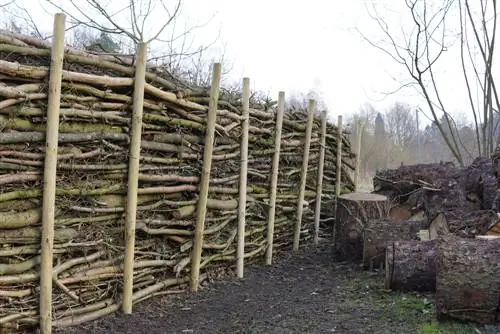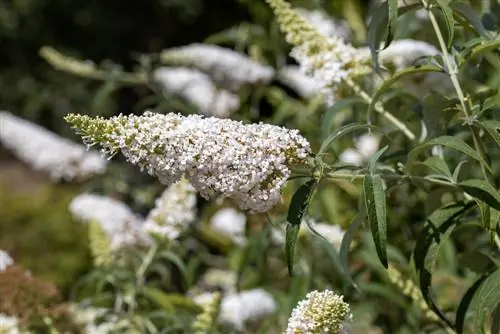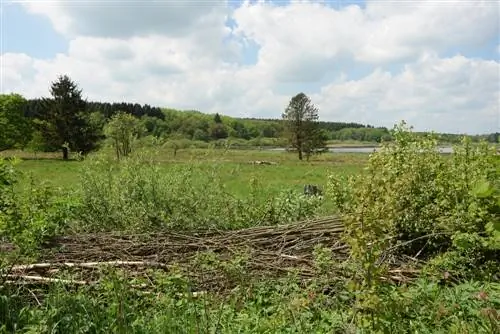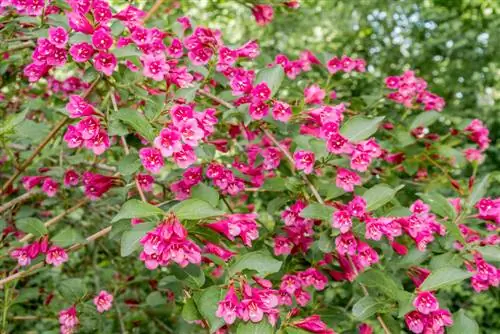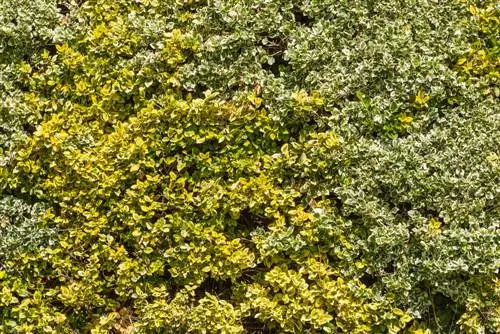- Author admin [email protected].
- Public 2024-01-15 08:07.
- Last modified 2025-06-01 06:02.
You can read how to properly create and green a Benje hedge here. All advantages at a glance. Tips on location, width, border distance and approval.
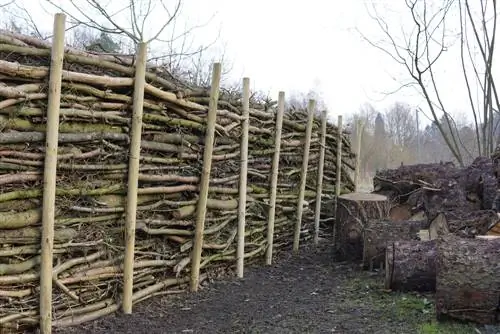
How do I create a Benje hedge correctly?
To create a Benje hedge, you need clippings, wooden stakes, sledgehammer, squared wood, marking cord, folding rule and a ladder. Mark and measure the hedge length, hammer the posts evenly apart, and fill in dead wood between the posts, starting with thick branches and thinning upwards.
Creating a Benje hedge
The Benje hedge is an enrichment for every natural garden. Easy to create, ecologically valuable and equipped with convincing advantages, the hedge can be integrated into any garden as a living wall. Important questions about the Benje hedge for the hobby garden receive a compact, comprehensible answer below:
What is a Benje hedge?
In the 1980s, the brothers Hermann and Heinrich Benjes developed an ingenious concept for the ecologically sensible recycling of clippings. With their brilliant ideas, the nature lovers gave the well-known deadwood hedges a new shine. The following definition sums up the term Benjeshecke:
Definition: Benje hedge is a loose, linear layer of shrub cuttings between wooden posts as a natural habitat for plants, insects, birds and small mammals.
What advantages does a Benje hedge have?
The success story of the Benjeshecke is based on a wide range of convincing advantages:
- Recycling on site: Return pruning in the garden to the cycle of nature.
- Privacy protection: Protects prying eyes from the property, seating area, terrace, compost heap, garbage cans.
- Wind protection: Protect wind-exposed locations from drafts, such as barbecue areas, swimming ponds, garden saunas.
- Habitat: Shelter, protection, food source and breeding station for animals and insects.
- Cost savings: Cost-effective construction of a hedge instead of investing in expensive shrubs.
- Flexibility: Suitable for any garden size from a spacious park to a small front garden.
Last but not least, a Benje hedge is pleasingly easy to care for. Only add dead wood when the cuttings sag downwards. If accompanying plants grow too exuberantly, pruning them will solve the problem.
Video: Benjeshecke - clippings become habitat for beneficial insects
Which location is suitable?
Reserve a sunny to partially shaded spot with normal to lean garden soil for your Benje hedge. If the soil at the location is too nutrient-rich or moist, we recommend adding sand. Otherwise, dominant wild herbs will establish themselves, such as nettles or pokeweeds.
Is a permit required?
There is no general answer to this question. In principle, all structures are subject to the building regulations and therefore require approval. This also includes enclosures made from living hedges, such as a Benje hedge. Because in Germany the building regulations are a matter for the states, different regulations apply in each federal state. It is therefore strongly recommended to inquire informally with the local building authority before construction begins. The lower nature conservation authority will also be happy to inform you whether a deadwood hedge requires approval in your region.
Which animals find shelter in a Benje hedge?
When dead wood is illuminated by the sun, life pulsates within it. In the cold season, a deadwood hedge offers numerous animals a cozy winter quarters. Look forward to these animals visiting your Benje hedge:
- Insects of all kinds, such as brimstone butterflies, lacewings, wild bees, bumblebees, ladybirds or even rare rhinoceros beetles.
- Amphibians: toads, frogs, lizards, salamanders, amphibians
- Birds: blackbirds, robins, wrens, sparrows, tits and other singing artists
- Small mammals: hedgehogs, squirrels, dormouse, dormice and bats.
If you offer this colorful group a place to retreat with a Benje hedge, you no longer have to worry about pests in the garden.
How do you create a Benje hedge correctly?
Spring is the best time to plant a Benje hedge. At this time of year, the clippings from trees and shrubs from this year's pruning care pile up. You will also need stakes (€33.00 on Amazon) with a diameter of around 5 cm, a sledgehammer, a piece of squared wood to help you drive in, marking cord, folding rule and a ladder. How to properly build a Benjes deadwood hedge:
- Measure the hedge lengthwise
- Stretch up the marking cord for 2 parallel rows of posts
- Width optionally 50 cm to 200 cm
- Sharpening posts
- Lay out posts at a distance of 60 cm to 100 cm along the marking cord
- Using a sledgehammer and squared wood, drive each post into the ground at least 30 cm deep
- Hedge height at your own discretion
- Fill the hedge frame with prunings
Start with thick branches that get thinner towards the top. This order is very convenient for hedgehogs and birds who want to settle under the Benje hedge or build their nests in the loose weave. Cut off any branches that stick out of the shape.
Excursus
Observe limit distance
The correct border distance of a Benje hedge avoids arguments with the neighbors. The rule of thumb applies: hedges up to 200 centimeters high must be planted at a distance of at least 50 centimeters from the property line. Special regional regulations take precedence, such as local fencing regulations. A call to the municipality ensures clarity and conflict-free construction of your Benje hedge.
Planting Benje hedge
Over time, the Benje hedge transforms itself into a source of life. While the clippings collapse, wind and animals carry plant seeds into the hedge. The seeds germinate, grow and green the hedge with regional perennials. You can speed up this process by planting the deadwood hedge in a targeted manner. The focus is on flowering food plants that beneficial insects in the garden cannot resist.
Green Benje hedge invitingly - tips
Make your selection carefully, because not every plant is beneficial for greening a deadwood hedge. Native wild plants that thrive naturally in your region are well suited. Highly recommended are flowers with simple, unfilled flowers that provide plenty of pollen and nectar for hungry wild bees, parasitic wasps, butterflies and other beneficial insects. To ensure that birds, hedgehogs and squirrels don't go away empty-handed, wild fruit bushes are a must. Be inspired by the following selection:
| Wildflowers | Botanical name | Wild fruit trees | Botanical name | Native climbing plants | Botanical name |
|---|---|---|---|---|---|
| Real Arnica | Arnica montana | Rock Pear | Amelanchier lamarckii | Yellow clematis | Clematis akebioides |
| Chamomile | Chamaemelum nobile | Cornelian cherry | Cornus mas | Large-leaved lady's mantle | Alchemilla mollis |
| Toadflax | Linaria vulgaris | Blackthorn | Prunus spinosa | Longerevermore | Lonicera caprifolium |
| Meadow knapweed | Centaurea jacea | Black Elderberry | Sambucus nigra | Clinging Knotweed | Polygonum aubertii |
| Meadow clover | Trifolium pratense | Hawthorn | Crataegus monogyna | Perennial vetch | Lathyrus latifolius |
When you plant a Benje hedge is your decision. It's easiest to sow wildflower seeds before piling up the clippings. In a finished deadwood hedge, plant pre-grown perennials in gaps created.
Plant wildflower strips in front of the Benje hedge
In the early stages, the Benje hedge is more of a bush wall than a decorative design element. With a creative trick you can give a freshly planted deadwood hedge a representative look. You can do this by planting a strip of tall wild perennials on both sides of the hedge. This variety selection is in perfect harmony with your Benje hedge:
- Elecampane (Inula helenium) with yellow ray flowers from June to September.
- Japan autumn anemone (Anemone japonica 'Whirlwind') with bright white cup flowers from August to October.
- mullein (Verbascum 'Pink Pixi') with purplish-pink candlestick flowers from June to August.
- Bleeding heart (Dicentra spectabilis) with deep pink heart flowers and white teardrop from May to June.
High goat's beard (Aruncus dioicus) with its fluffy flowers feels right at home in the shade of a head-high Benje hedge. For colorful flower decorations, place the shade-flowering splendor (Astilbe thunbergii 'Ostrich Feather') next to it.
FAQ
Can you plant a Benje hedge on the edge of a field?
Even in the Middle Ages, deadwood hedges shaped the landscape of rural regions as windbreaks on the edge of fields. However, terms such as building regulations, fencing regulations or building plans were still unknown at that time. Today it is advisable to ask the municipality, nature conservation authority or building authority in advance whether you can create a Benje hedge on the edge of the field.
Is the Benje hedge suitable for an allotment garden?
You can create a Benje hedge in any size you want. Simply measure the available space in your allotment and adjust the dimensions of the dead wood corner accordingly. In the small format, a width of 50 centimeters or more is recommended, with a height of 100 cm up to chest height.
Which clippings are not allowed in the Benje hedge?
Shrub cuttings from trees that sprout again from cut shoots, such as blackberries, are not suitable for a Benje hedge. In the vicinity of nature reserves, cuttings from shrubs that carry harmful organisms, such as vines with phylloxera infestation or buxus with boxwood borers, are questionable. Such neozoa have no natural enemies in our latitudes and can cause fatal damage to biotopes.
We don't have enough prunings for the Benje hedge. What to do?
If there is not enough clippings, contact the local road maintenance department or a large gardening company. These areas struggle with mountains of dead wood in spring and fall and are grateful for a buyer. If the forestry office allows it, you will also find what you are looking for in the forest when looking for fallen branches or broken wood to fill your Benje hedge.
How can I beautify a Benje hedge?
Place brightly painted flower pots upside down on the posts of the hedge frame. If you fill each pot with wood shavings, beetles will be happy about the comfortable shelter. Integrate a self-built hedgehog house into the hedge as a picturesque eye-catcher. Authentic accessories are rustic plant containers, such as disused wheelbarrows or old wooden tubs, which you can plant lavishly with wildflowers.
Is there any disadvantages to the Benje hedge?
The main disadvantage of a Benje hedge is that clippings from certain types of trees can sprout and grow again, like the canes of a blackberry. It is to be complained that the nutrient-rich location is home to highly competitive, invasive weeds that suppress the growth of wild fruit trees. Unless you specifically green a deadwood hedge, it will take 30 years for natural, species-rich vegetation to emerge.

